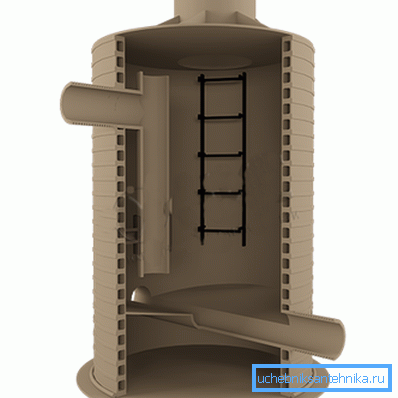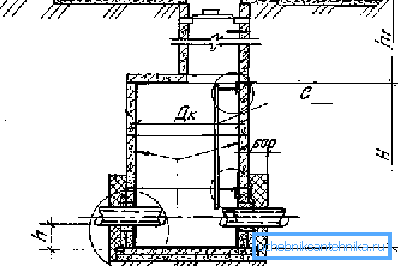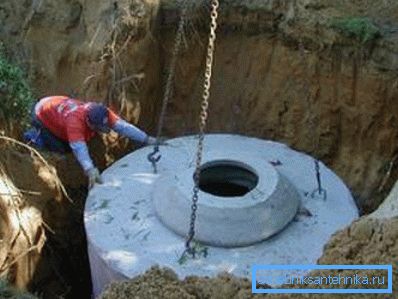Standard project of a sewer well for the independent
Effectively working sewer system will be the key to a comfortable stay in a private house. Installation of a sewer well - one of the main stages in its device. However, its design is quite simple, which is considered the main argument for self-erection.
Having done the installation with your own hands, you will significantly reduce the cost of home sewage and you will surely know the quality of the result. In addition, you will be able to acquire new useful skills that will come in handy again and again.

Process
It is best to start working with a detailed design of the overall sewage system for the house. A typical project can be taken as a basis, since such sewer wells work without problems for many years..

Compiled preliminary scheme, the developed project, as well as estimates make it possible to significantly reduce labor costs, save time and reduce financial investments. And let you take building materials with a 20% margin, with strict adherence to the estimates, you will still find yourself in good profit.
What is the sewer well plan
This stage includes the following items:
- Choosing a place for the future well. A standard project is useful here, since such facilities are usually located below the level of the main building on the site. In this case, the process of setting up the well and laying the pipes, which ensure efficient discharge, is facilitated.
- Determine the place where the sewer pipe will go out. It is unlikely that you want to dig a trench around the perimeter of the building, so you should choose the shortest path from the house to the sewer well.
- Draw a diagram for clarity, with respect to scale. This stage makes it possible to determine the required length of pipes, the number of fittings and connections, as well as the conditions in which the pipeline will be laid. The latter include the composition of the soil, the depth of the trench for the sewer pipe, the presence of possible obstacles.

Upon completion of the preparatory work, we will receive a detailed plan. However, before you begin to implement it, you need to figure out which typical project of sewage wells from the existing ones you should build.
Kinds
There are several types of such structures. Although this classification can be taken largely conditional. Most often, there are combined options, the standard design of which allows them to perform several functions simultaneously.
Experts share sewer wells on:
- differential, which equip when the characteristics of the site makes it impossible to lay the pipeline with a certain slope;
- inspection, used to ensure the repair and prevention of sewage systems, as well as for access to it during cleaning works. Therefore, when the external sewage pipeline is very long or has a tortuous configuration, you cannot do without inspection wells.
Tip: arrange the first observation well no more than 12 m from the place where the sewer pipe leaves the house, then the distance can be 15 m. In addition, do not place it closer than 3 m from the foundation of the building.
- rotary, performing the function of viewing, but they are satisfied at the points where the sewer turns 90 ?. These sections of the pipeline are considered to be the most problematic, since there is a high risk of blockages, so be sure to provide access to them;
- filtration and storage wells are needed for wastewater treatment, which then after filtration is diverted to the ground. They may be part of a septic tank.
What type of well you have not chosen, its device has almost the same scheme for each variety.
It includes:
- working chamber;
- neck that goes to the surface.
The latter usually has a protective hatch that allows you to get into the chamber of the well.

Manufacturing drain well
This is the simplest of all options, consists of a reservoir where wastewater accumulates, and their pre-treatment takes place:
- Partial decomposition of accumulated effluent occurs under the action of anaerobic bacteria, due to which water, gas and inert sludge are obtained from toxic organic matter.
- SNiP requires that it be located no closer than 5 m from the foundation of the building. It is also important to remove it to the maximum distance from the well, the well and other sources of drinking water. On sandy and sandy soils, the distance is 50 m, on heavy and medium loams, and also on soils with a predominance of clay - up to 25 m.
- The bottom of the well is first filled with a layer of rubble to a height of 200-300 mm, and then it must be filled with concrete to prevent filtering of dirty sewage into the ground. The shape of the structure can be square or round. The depth depends on the daily volume of wastewater.
- In the single-chamber version, the principle of operation resembles a cesspool, so it requires periodic pumping, which increases the cost of its maintenance. If we make a structure resembling a septic tank consisting of 2-3 chambers, then you can get rid of such inconvenience, although the price of the structure will increase.
- Important in the construction of this structure is sealing walls. The instruction assumes that they can be from reinforced concrete rings, with sealing joints, or from a rubble stone or used bricks on a cement mortar.
In the latter case it is necessary to process the surface from the inside with bitumen. It is also possible to build a chamber using formwork into which concrete is poured, then it is not necessary to seal the walls additionally.

Tip: when using reinforced concrete rings, use construction equipment to install them so as not to damage them.
- The slab of the well can serve as a reinforced concrete plate with a place for installing the hatch. It is used standard - plastic with metal reinforcement or metal.
Conclusion
Any kind of sewer has almost the same device. They differ only in the purpose and place of installation. In the presented video in this article you will find additional information on this topic.